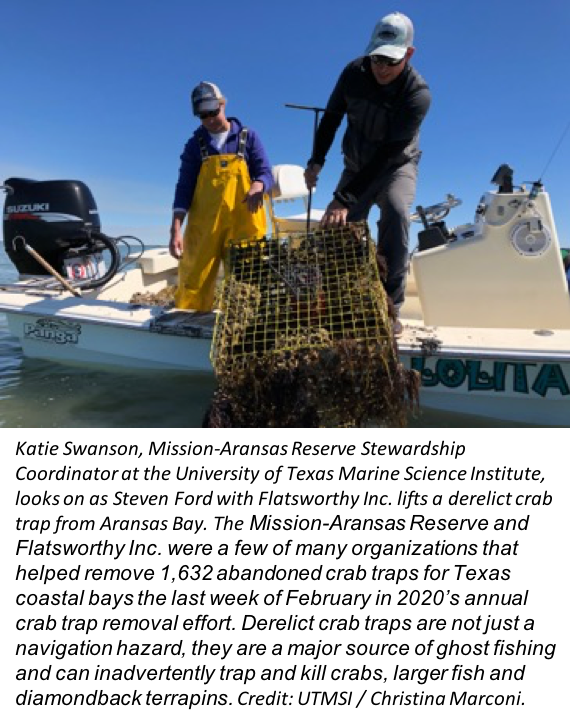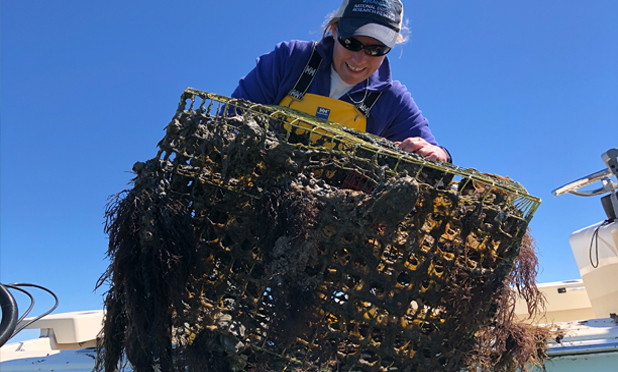 Every February, Texas Parks and Wildlife Department closes the bays to commercial and recreational crabbing for 10-days each February. This temporary closure enables a coordinated effort by agencies and organizations to remove derelict crab traps. Derelict traps can cause problems as they continue to entrap and kill crabs, fish and turtles.
Every February, Texas Parks and Wildlife Department closes the bays to commercial and recreational crabbing for 10-days each February. This temporary closure enables a coordinated effort by agencies and organizations to remove derelict crab traps. Derelict traps can cause problems as they continue to entrap and kill crabs, fish and turtles.
This year, 1,632 traps were removed from the three coastal bay systems on the Texas mid-coast (Lavaca/Matagorda, San Antonio and Aransas Bays). “It’s very important to remove these old traps from the bays. Not only are they a source of ghost fishing, but they’re also navigation hazards,” said co-organizer Katie Swanson, Mission-Aransas Reserve Stewardship Coordinator at the University of Texas Marine Science Institute.
Removal of derelict crab traps is a massive effort that involved 68 boat days and 164 volunteer days. The effort was led by San Antonio Bay Partnership, who organized many groups, including U.S. Fish and Wildlife Service’s Aransas National Wildlife Refuge, Texas Parks and Wildlife Department Coastal Fisheries, local chapters of the Coastal Conservation Association, the Guadalupe Blanco River Authority, Guadalupe Blanco River Trust, International Crane Foundation, Mid-Coast Texas Master Naturalists, Mission-Aransas Reserve at the University of Texas Marine Science Institute, Dallas Zoo / Bay Flats Lodge, Texas SeaGrant, FlatsWorthy Inc., Lavaca-Navidad River Authority, Lavaca Bay Foundation, Matagorda Bay Foundation and many individual volunteers.
“The effort was a great success! Participation was up from last year and we covered a wider area. The Lavaca Bay Foundation organized a search of Lavaca Bay that hasn’t been cleaned in a while. New technology was employed to improve efficiency,” said San Antonio Bay Partnership Chairman Allan Berger.” “While the technology helps, it’s still about boats, volunteers and eyes on the water. The tally is significantly higher than last year, due to the expanded area and greater effort.”
This is the first year that technology was used to mark abandoned traps from the air and to make those data available to volunteers on the water. Berger continues “The data reveals that many of the derelict traps are on the shoreline, likely the result of weather events. However, a significant number appear to be in place and not picked up by commercial crabbers. It is anticipated that an analysis of the data can reveal root-causes and result in fewer lost traps in the future.”
The derelict crab clean-up effort was supported with funds from HEB, Citgo, Dallas Zoo and Texas SeaGrant in addition to in-kind support from U.S .Fish and Wildlife Service, Texas Parks and Wildlife Department, Guadalupe Blanco River Authority, the Guadalupe Blanco River Trust, International Crane Foundation, Mission-Aransas Reserve at the University of Texas Marine Science Institute, Bay Flats Lodge, FlatsWorthy Inc., Lavaca-Navidad River Authority, Lavaca Bay Foundation, and Matagorda Bay Foundation, and the captains who provided their private boats.
Berger says that “while the cleanup is a lot of work, it is essential to keeping our bays clean and productive—and it’s fun”. If you want to be included in the early planning for next year, contact Allan Berger at This email address is being protected from spambots. You need JavaScript enabled to view it..
We'd also like to give a special thanks to International Crane Foundation and Flatsworthy Inc. for boat use.









